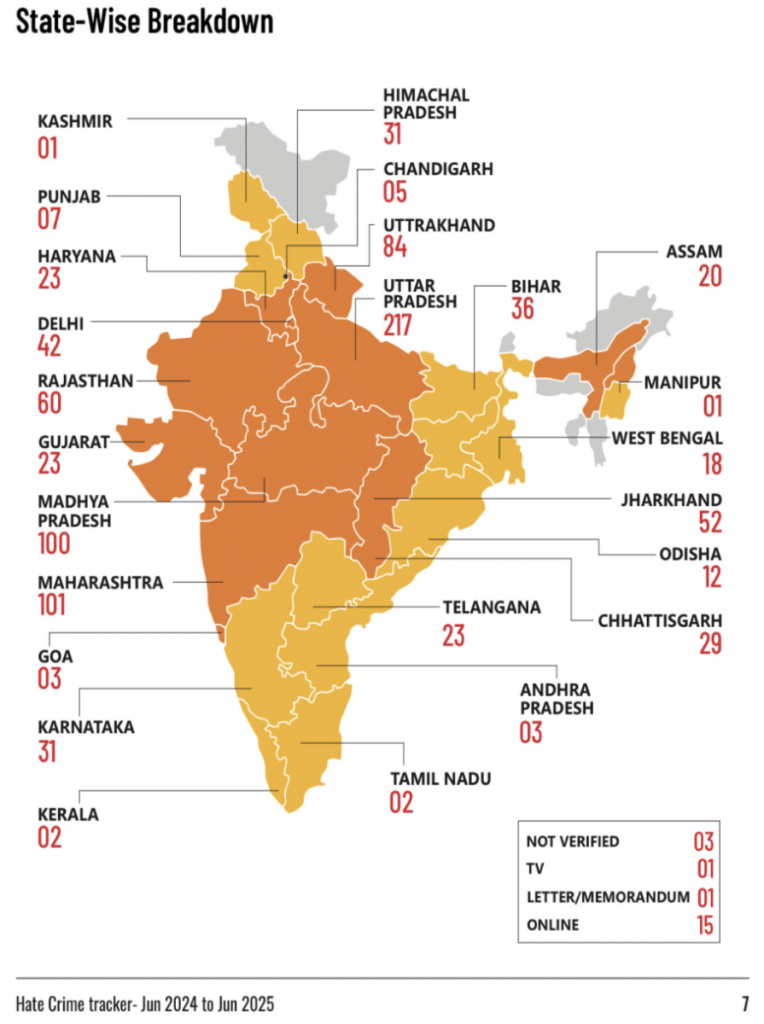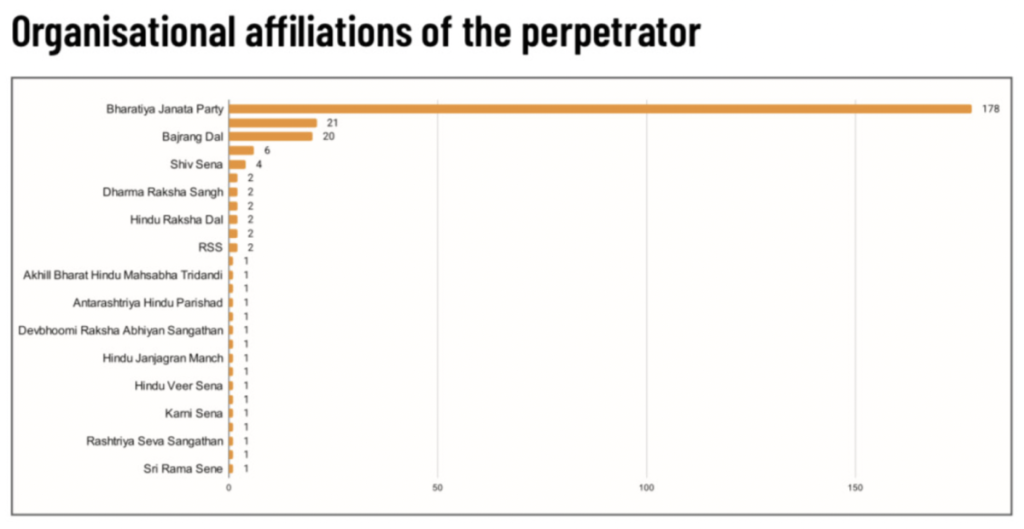Anti-Minority Hate Crimes Increased in Number, Intensity in First Year of Modi 3.0: Report
Hate crimes against religious minorities have increased in number and intensity in the past year and the violence is directed at Muslims, Dalits, Adivasis, and Christians amongst other minorities in ways that are systematic, vengeful, and going nowhere, a report by the Association for Protection of Civil Rights has found.
The report is titled 'Hate Crime Report: Mapping First Year of Modi’s Third Government'. It comes at the end of a year of systematic research on communal violence and inflammatory speech targeting religious minorities in India.
The Association for Protection of Civil Rights or APCR is a non-profit civil rights organisation established in 2006.
The group points out that despite the rising intensity and frequency of targeted attacks on religious minorities, there remains “no systematic or institutional effort to record or document hate crimes.”
What is a 'hate crime?'
The study, spanning Narendra Modi’s third stint as prime minister – June 7, 2024 to June 7, 2025 – maps and analyses hate crimes during this period, decoding the identity markers of the perpetrators and victims, the formers' motivations and the intensity of the action.
It also sets the definition of a hate crime, according to the United Nations’ Rabat Plan of Action, which focuses upon hate crimes and their scope. The study outlines that “hate crimes” are motivated by “prejudice or hostility” towards the “social identity of the victim”, and also involve or lead to damage to belongings, persons, or property. Hence crimes like assault, boycott, expulsion, murder, arson, vandalism and such, or threats of the same, come under the purview of such acts.
The report defines hate speech as offensive discourse which targets individuals based on their social identity.
Key findings
The report claims that a total of 947 hate crime incidents took place in the time period considered. Of these 345 were hate speeches and 602 were hate crimes.
It analysed that out of the 602 hate crimes, 173 involved physical violence targeted at minorities. In 25 of these, the victim died. All victims were Muslims.
The incidents also affected 25 Hindu individuals. While not the main victims or targets of hate crime, their presence at the scene resulted in harm done to them. Here, Hindu women were more affected than Hindu men.
Out of the 345 hate speeches made in the year, 178 were made by individuals associated with the Bharatiya Janata Party, the report found.
It said that BJP-ruled states are more prone to incidents of hate crime.
Major analyses
The report offers month-by-month documentation of hate crimes and hate speeches in the past one year. It claims that hate crimes have become regular to such an extent that it has become “normal” for 80 such incidents to be recorded in the country in a month.
According to the data collected, October 2024 and April 2025 saw the highest number of hate crimes and hate speeches across the country.
October recorded 80 hate crimes, the majority of them were related to the participation of Muslim men in Dandiya/Garba and false accusations of Love Jihad, while the last week was dominated by a campaign by right-wing outfits advocating for an economic boycott of Muslim-owned businesses.
The worst-hit states were Uttar Pradesh with 21 hate crimes, Madhya Pradesh with 16, and Maharashtra with 11.

Source: APCR 'Hate Crime Report: Mapping First Year of Modi’s Third Government'.
It alleges that in Uttar Pradesh there were multiple incidents in which Muslim youth were barred from being part of Navratri celebrations, they were often harassed and assaulted. There was also a large-scale campaign by Hindutva outfits against what they labelled were “religious conversions”, with pastors being either “threatened or arrested, leading to a disruption in the Christian community.”
It also said that there was a “coordinated campaign” in Maharashtra by right-wing outfits, which involved the "assault of Muslims, cow vigilantism, and interruption of prayer meetings of Christians and sermons of Muslims.”
It also reported 96 hate crimes in April this year, Uttar Pradesh with 27 being the worst hit. The report found a pattern in the rise in hate crimes after the Pahalgam terror attack. Multiple Muslims were targeted in its aftermath across the country, it said.
April also witnessed celebrations of Ram Navami and Easter. The report is among many that note that both Easter and Ram Navami saw hate crimes. There were reports of Easter celebrations being interrupted in Ahmedabad and Raigarh, while Ram Navami processions led to hate crimes targeting Muslims in various cities like Mumbai and Jodhpur.
In the same month, a sexual assault in Nainital led to communal violence targeting Muslims. The passing of the Waqf Amendment Act in the parliament as well as agitation against it from Muslims was also seen.
Weaponising Hindu festivals
Hindu festivals such as Ganesh Chaturthi, Navratri, Ram Navami, and Holi consistently emerged as occasions for hate crimes and communal mobilisation. The Hate Crime Tracker documents how Hindutva organisations, aided by political rhetoric, media propaganda, and police inaction, systematically converted religious celebrations into battlegrounds of targeted violence against Muslims and Christians.
During Ganesh Chaturthi in September 2024, Hindutva outfits vandalised Muslim homes in Panna, Madhya Pradesh, while in Thane, a Muslim man was assaulted over false accusations of “urine jihad” and interfaith proximity. These attacks were framed as reactions to perceived slights against Hindu sentiments during the festival.
Ram Navami in April 2025 saw perhaps the most explicit weaponisation. In Jodhpur, Rajasthan, a tableau portraying a chained Muslim man was paraded through the streets. That same month, a mosque in Barmer and a madrasa in Telangana were vandalised. Muslims were banned from entering certain villages in Rajasthan.
In Baghpat, Uttar Pradesh, a Muslim man was attacked by Holi revellers for refusing to participate in celebrations. In Bareilly, Muslim boys were denied access to a public park during Holi celebrations. These incidents were justified by claiming that Muslims had “hurt Hindu sentiments.”
Police complicity
The report alleges that the police response remained largely passive or complicit. Of 602 hate crimes documented in the year, only 13% resulted in first information reports.
In Jabalpur, Madhya Pradesh, a Christian priest was assaulted by Bajrang Dal members inside a police station, where he had gone to seek help.
In multiple Navratri-related incidents, police were recorded aiding Hindutva groups in checking IDs of Muslim attendees at Garba venues.
Role of media
Right-wing media played a catalytic role. Sudarshan TV, for instance, aired a segment titled “Garba ke Naam pe Jihad?” in October, spreading the baseless claim that Garba events were targeted by Muslim youth for seduction and conversion. These narratives were further amplified online, creating a feedback loop between hate speech and physical violence.
As noted earlier, these festival-linked incidents – especially during Navratri, Ram Navami, and Holi – also coincided with polling calendars in states like Maharashtra, Jharkhand, and Uttarakhand, suggesting a deliberate political strategy.
Election campaigns
The study also provides a correlation between elections of any kind and a spike in hate crimes and hate speeches. It claims that “earlier data had limited the assumption of this occurring only during elections for the parliament and the legislative assembly”, but according to this report, even “local elections could also become the loci of hate crime incidents, particularly hate speeches, as was revealed during the election for the Local Councillor in Uttarakhand.”
Elections took place in Jammu and Kashmir, Haryana, Jharkhand, Maharashtra and Delhi within this year, and Uttarakhand had local council elections. BJP won four out of six of these elections. This study reports that these four states showed more than normal cases of hate crimes and hate speeches.
The study said that in Delhi, Jharkhand, Maharashtra and Uttarakhand, the spike in hate crimes indicates a “pattern of careful plotting of hate crimes and hate speech incidents towards creating an atmosphere favourable for the BJP during elections.”
The study echoes what political scientists and rights activists have long argued – that religion-based violence has accompanied the BJP’s rise to power.
This strategy manifests in the form of hate speeches by politicians like Maharashtra's Nitesh Rane who threaten to enter mosques and “kill Muslims one by one”, or Assam chief minister Himanta Biswa Sarma who says he would “take sides against Muslims”. This narrative, when echoed by those in power, creates a public perception that Muslims are inherently threatening.
Complicity
Another major finding this report presents is the complicity of senior BJP leaders, including chief ministers, Union Ministers and the prime minister Narendra Modi himself in justifying hate speech and hate crime offenders and also actively taking recourse of hate speech themselves.
According to APCR, hate speeches against religious minorities creates a vitriolic atmosphere in India for them. "They sow issues, and lend a certain confidence-building to the right-wing outfits involved in hate crime incidents. It also filters the malice of minorities to the masses.”

Source: APCR's 'Hate Crime Report: Mapping First Year of Modi’s Third Government'
Of the 345 hate speech incidents recorded and analysed in the year, 109 were made by a member of a political party or affiliated outfit, 139 were made by individuals elected to public offices.
Most notably, five hate speeches were delivered by Modi himself, 63 by chief ministers of BJP governments, and 71 by other elected individuals.
Another major finding was that two judges and a governor gave hate speeches this year.
This is not the first time that the active role of senior BJP leaders in inciting violence against minorities for electoral campaigns have been explored in a report. A 2024 report by the Human Rights Watch found that Modi’s election campaign was “fuelled” by hate speech. It alleges that Modi and the senior BJP leaders “repeatedly made statements inciting discrimination, hostility, and violence against marginalised groups” during their whole election campaign. It said that Modi himself made Islamophobic remarks in 110 speeches.
This is also confirmed by the APCR which finds that hate speeches by the BJP leadership have become the pivot around which hatred and violence against minorities by smaller affiliated Hindutva groups are organised.
Violence and xenophobic agendas, the report shows, is not the work of fringe elements but stems directly from the top BJP leadership. Among the 345 hate speeches made last year, BJP topped the list with 178 hate speech incidents, followed by Vishwa Hindu Parishad with 21 hate speech incidents and Bajrang Dal with 20.
The APCR report does not just chronicle a year of hate, it captures a country going through a dangerous transformation. Hindutva is no longer just an ideology; it’s a governing framework, evident in the routinisation of violence, the targeting of minorities, and the silence of institutions meant to protect them.
Tamoghna Chakraborty is a reporting intern at The Wire.
This article went live on June twenty-seventh, two thousand twenty five, at twenty-five minutes past five in the evening.The Wire is now on WhatsApp. Follow our channel for sharp analysis and opinions on the latest developments.




